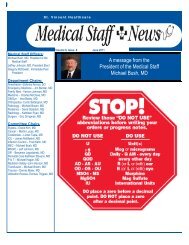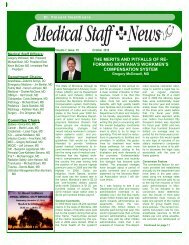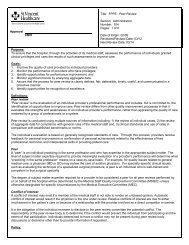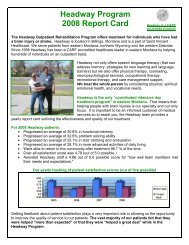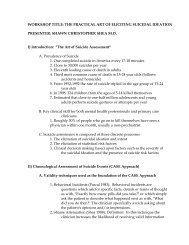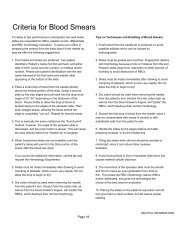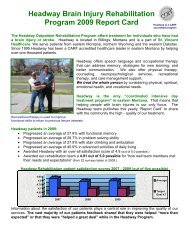AHA/ASA Guideline Guidelines for the Prevention of Stroke in ...
AHA/ASA Guideline Guidelines for the Prevention of Stroke in ...
AHA/ASA Guideline Guidelines for the Prevention of Stroke in ...
You also want an ePaper? Increase the reach of your titles
YUMPU automatically turns print PDFs into web optimized ePapers that Google loves.
232 <strong>Stroke</strong> January 2011factors have all failed to demonstrate a reduction <strong>in</strong> cardiovascularevents or death <strong>in</strong> <strong>the</strong> groups receiv<strong>in</strong>g <strong>in</strong>tensiveglucose <strong>the</strong>rapy. In <strong>the</strong> Action to Control Cardiovascular Risk<strong>in</strong> Diabetes (ACCORD) trial, 10 251 patients with type 2diabetes and vascular disease or multiple risk factors wererandomly assigned to an <strong>in</strong>tensive treatment program target<strong>in</strong>ga glycohemoglob<strong>in</strong> level <strong>of</strong> 6% versus a standardprogram with a goal HbA 1c level <strong>of</strong> 7% to 7.9%. 39 The trialwas halted after a mean <strong>of</strong> 3.5 years <strong>of</strong> follow-up because <strong>of</strong>an <strong>in</strong>creased risk <strong>of</strong> death <strong>in</strong> patients randomized to <strong>the</strong><strong>in</strong>tensive treatment program (HR, 1.22; 95% CI, 1.01 to1.46). There was no significant difference <strong>in</strong> <strong>the</strong> rate <strong>of</strong>nonfatal stroke (HR, 1.06; 95% CI, 0.75 to 1.50; P0.72) or<strong>in</strong> <strong>the</strong> primary end po<strong>in</strong>t, which was a composite <strong>of</strong> nonfatalheart attack, nonfatal stroke, and death due to a cardiovascularcause (HR, 0.90; 95% CI, 0.78 to 1.04; P0.16). TheAction <strong>in</strong> Diabetes and Vascular Disease (ADVANCE) trialalso failed to show a benefit <strong>in</strong> secondary prevention <strong>of</strong>cardiovascular events. In this trial 11 140 patients with type 2diabetes and a history <strong>of</strong> macrovascular disease or ano<strong>the</strong>rrisk factor were randomly assigned to <strong>in</strong>tensive glucosecontrol (target 6.5%) or standard glucose control (targetHbA 1c 7%). 40 Thirty-two percent <strong>of</strong> subjects had a history<strong>of</strong> major macrovascular disease, <strong>in</strong>clud<strong>in</strong>g 9% with a history<strong>of</strong> stroke. There was no significant reduction <strong>in</strong> <strong>the</strong> occurrence<strong>of</strong> macrovascular events alone (HR, 0.94; 95% CI, 0.84to 1.06; P0.32) or nonfatal stroke (3.8% <strong>in</strong> both treatmentarms). In contrast to <strong>the</strong> ACCORD trial, <strong>the</strong>re were nosignificant differences <strong>in</strong> <strong>the</strong> rate <strong>of</strong> deaths between <strong>the</strong> studygroups. F<strong>in</strong>ally, <strong>the</strong> Veterans Affairs Diabetes Trial, consist<strong>in</strong>g<strong>of</strong> 1791 veterans with type 2 diabetes assigned to<strong>in</strong>tensive blood glucose treatment or standard treatment,found no significant difference between <strong>the</strong> 2 groups <strong>in</strong> anycomponent <strong>of</strong> <strong>the</strong> primary outcome, which consisted <strong>of</strong> timeto occurrence <strong>of</strong> a major cardiovascular event, or <strong>in</strong> <strong>the</strong> rate<strong>of</strong> death due to any cause (HR, 1.07; 95% CI, 0.81 to 1.42;P0.62). 40 The results <strong>of</strong> <strong>the</strong>se trials <strong>in</strong>dicate <strong>the</strong> glycemictargets should not be lowered to HbA 1c 6.5% <strong>in</strong> patientswith a history <strong>of</strong> cardiovascular disease or <strong>the</strong> presence <strong>of</strong>vascular risk factors.Among patients who have had a stroke or TIA and havediabetes, guidel<strong>in</strong>es have been established <strong>for</strong> glycemiccontrol 41 and BP management. 14Recently <strong>the</strong> use <strong>of</strong> pioglitazone has been evaluated <strong>in</strong>5238 patients with type 2 diabetes and macrovascular disease.In <strong>the</strong> PROspective pioglitAzone Cl<strong>in</strong>ical Trial In macroVascularEvents (PROactive), <strong>the</strong>re was no significant reduction<strong>in</strong> <strong>the</strong> primary end po<strong>in</strong>t <strong>of</strong> all-cause death or cardiovascularevents <strong>in</strong> patients randomly assigned to pioglitazone comparedwith placebo (HR, 0.78; 95% CI, 0.60 to 1.02). 42,43Remarkably, among patients who entered PROactive with ahistory <strong>of</strong> stroke, pioglitazone <strong>the</strong>rapy was associated with a47% relative risk reduction <strong>in</strong> recurrent stroke (HR, 0.53;95% CI, 0.34 to 0.85), and a 28% relative risk reduction <strong>in</strong>stroke, MI, or vascular death (HR, 0.72; 95% CI, 0.53 to1.00). Conversely, rosiglitazone, ano<strong>the</strong>r <strong>of</strong> <strong>the</strong> thiazolid<strong>in</strong>edioneclass <strong>of</strong> drugs, has been l<strong>in</strong>ked to <strong>the</strong> occurrence<strong>of</strong> heart failure and possible fluid retention, which led to <strong>the</strong>US Food and Drug Adm<strong>in</strong>istration (FDA) requir<strong>in</strong>g a boxedwarn<strong>in</strong>g <strong>for</strong> this class <strong>of</strong> drugs <strong>in</strong> 2007. An <strong>in</strong>creased risk <strong>of</strong>MI or cardiovascular death with <strong>the</strong> use <strong>of</strong> rosiglitazone hasbeen suspected but not conclusively proven. The Insul<strong>in</strong>Resistance Intervention after <strong>Stroke</strong> (IRIS) trial is an ongo<strong>in</strong>gstudy funded by <strong>the</strong> National Institute <strong>for</strong> NeurologicalDisorders and <strong>Stroke</strong> (NINDS) <strong>in</strong> which patients with TIA orstroke are randomly assigned to pioglitazone or placebo <strong>for</strong> aprimary outcome <strong>of</strong> stroke and MI.Recommendation1. Use <strong>of</strong> exist<strong>in</strong>g guidel<strong>in</strong>es <strong>for</strong> glycemic control andBP targets <strong>in</strong> patients with diabetes is recommended<strong>for</strong> patients who have had a stroke or TIA (Class I;Level <strong>of</strong> Evidence B). (New recommendation; Table 3)C. LipidsLarge epidemiological studies <strong>in</strong> which ischemic and hemorrhagicstrokes were dist<strong>in</strong>guishable have shown a modestassociation <strong>of</strong> elevated total cholesterol or low-density lipoprote<strong>in</strong>cholesterol (LDL-C) with <strong>in</strong>creased risk <strong>of</strong> ischemicstroke and a relationship between low LDL-C and greaterrisk <strong>of</strong> ICH. 44–46 With regard to o<strong>the</strong>r lipid subfractions,recent studies have <strong>in</strong>dependently l<strong>in</strong>ked higher serum triglyceridelevels with occurrence <strong>of</strong> ischemic stroke 47,48 andlarge-artery a<strong>the</strong>rosclerotic stroke, 49 as well as associat<strong>in</strong>glow high-density lipoprote<strong>in</strong> cholesterol (HDL-C) with risk<strong>of</strong> ischemic stroke. 50 A meta-analysis <strong>of</strong> 90 000 patients<strong>in</strong>cluded <strong>in</strong> stat<strong>in</strong> trials showed that <strong>the</strong> larger <strong>the</strong> reduction <strong>in</strong>LDL-C, <strong>the</strong> greater <strong>the</strong> reduction <strong>in</strong> stroke risk. 51 It wasunclear, however, up until recently what beneficial role, ifany, that stat<strong>in</strong>s played <strong>in</strong> stroke patients without establishedcoronary heart disease (CHD), with regard to vascular riskreduction, particularly prevention <strong>of</strong> recurrent stroke. 52A retrospective subset analysis <strong>of</strong> 3280 subjects <strong>in</strong> <strong>the</strong>Medical Research Council/British Heart Foundation HeartProtection Study (HPS) with a remote (mean, 4.3 years)history <strong>of</strong> symptomatic ischemic cerebrovascular diseaseshowed that simvastat<strong>in</strong> <strong>the</strong>rapy yielded a 20% reduction <strong>in</strong>major vascular events (HR, 0.80; 95% CI, 0.71 to 0.92). 53 For<strong>the</strong> end po<strong>in</strong>t <strong>of</strong> recurrent strokes, simvastat<strong>in</strong> exerted no netbenefit (HR, 0.98; 95% CI, 0.79 to 1.22), be<strong>in</strong>g associatedwith both a nonsignificant 19% reduction <strong>in</strong> ischemic strokeand a nonsignificant doubl<strong>in</strong>g <strong>of</strong> hemorrhagic stroke (1.3%simvastat<strong>in</strong>, 0.7% placebo; HR, 1.91; 95% CI, 0.92 to 3.96;4.3% simvastat<strong>in</strong> versus 5.7% placebo; P0.0001). Given<strong>the</strong> exploratory nature <strong>of</strong> this post hoc subgroup analysis <strong>of</strong>HPS, it rema<strong>in</strong>ed unclear whe<strong>the</strong>r stroke patients woulddef<strong>in</strong>itively benefit from stat<strong>in</strong> treatment to lessen futurevascular risk (<strong>in</strong>clud<strong>in</strong>g recurrent stroke), especially thosewithout known CHD. 54In <strong>the</strong> <strong>Stroke</strong> <strong>Prevention</strong> by Aggressive Reduction <strong>in</strong>Cholesterol Levels (SPARCL) study, 4731 persons withstroke or TIA, LDL-C levels between 100 mg/dL and 190mg/dL, and no known history <strong>of</strong> CHD were randomlyassigned to 80 mg <strong>of</strong> atorvastat<strong>in</strong> daily versus placebo. 55Dur<strong>in</strong>g a median follow-up <strong>of</strong> 4.9 years, fatal or nonfatalstroke occurred <strong>in</strong> 11.2% who received atorvastat<strong>in</strong> versus13.1% who received placebo (5-year absolute reduction <strong>in</strong>risk, 2.2%; HR, 0.84; 95% CI, 0.71 to 0.99; P0.03). TheDownloaded from stroke.ahajournals.org by on March 8, 2011



